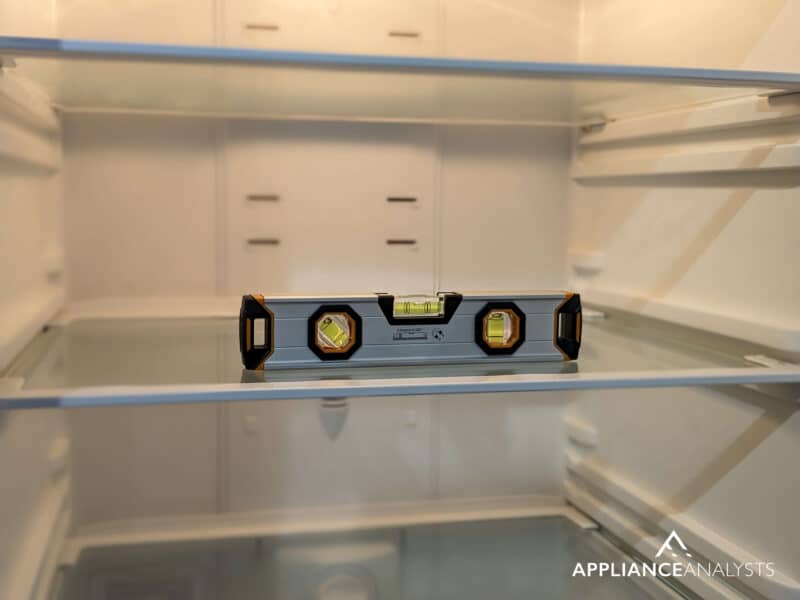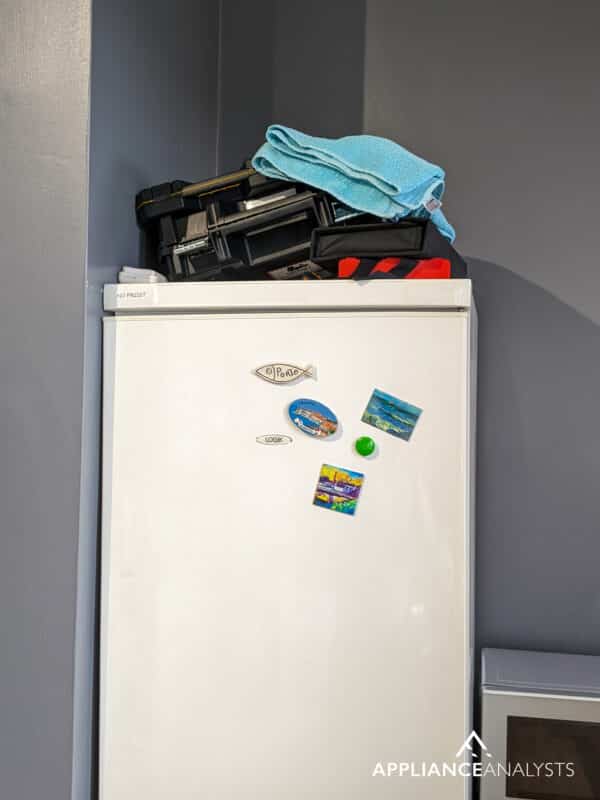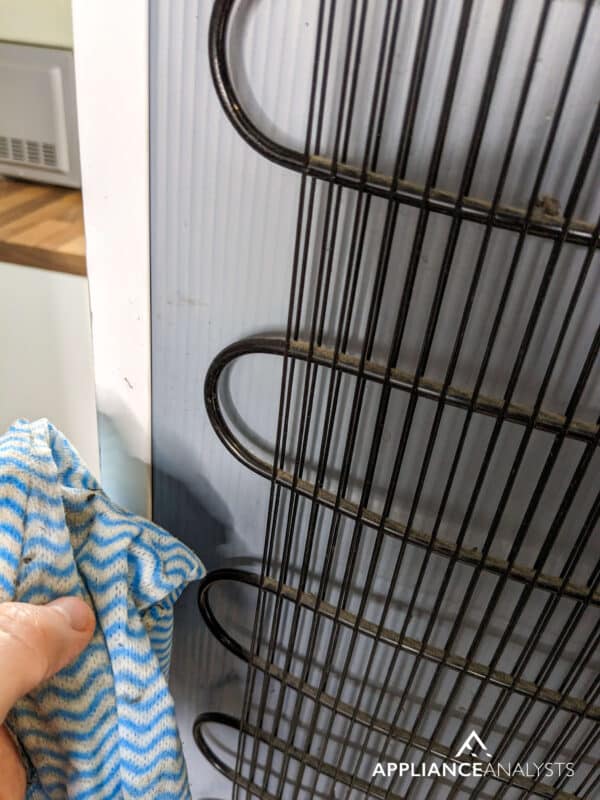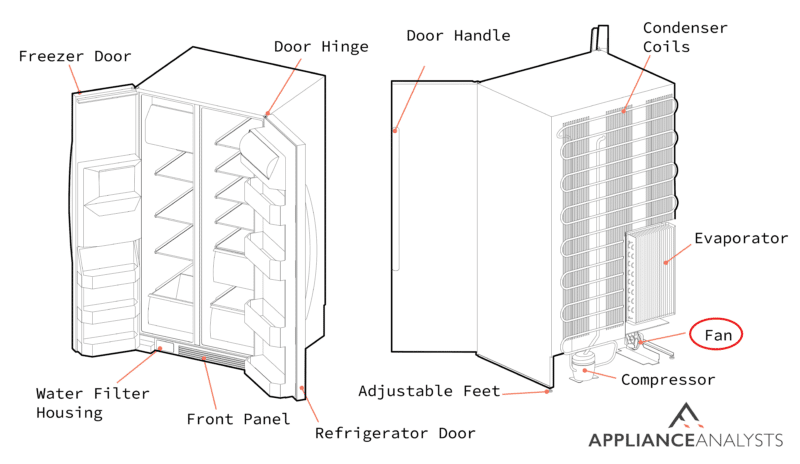We've independently reviewed this article to make sure it's as accurate as we can make it.
To find out more about our article creation and review process, check out our editorial guidelines.
Is your fridge vibrating or shaking?
You’re not alone! I know how concerning it can be when your refrigerator shakes excessively, especially when you don’t know what’s causing it.
Luckily, you’ve come to the right place to fix the issue.
If your fridge is vibrating or shaking, ensure it is level, check for loose components, remove any external obstructions, and clean the condenser coils. If the issue persists, it’s also important to examine the sealed system lines and inspect the fans and compressor mounts.
Read on to learn how to fix the shaking issue!
Why trust us? This article was written by Craig Anderson and Andy Fulenchek.
Craig has helped thousands of other homeowners repair their appliances since 2016.
Andy is one of our resident appliance repair experts with over a decade of experience. He currently runs his appliance repair company with a team of trusted technicians.
Keeping Your Fridge From Vibrating or Shaking: 7 Steps
While it’s normal for refrigerators to experience mild vibrations when the compressor is running, if you notice strong shaking, it’s likely a sign of an underlying issue.
Don’t worry, though! In this section, I’ll guide you through the different solutions you can try to keep your fridge from shaking or vibrating excessively.
Are you ready? Let’s dive in!
#1 Level Your Fridge
In my experience, a fridge can vibrate or shake if it’s not level on the floor.
To help you better understand why it’s important to level your fridge, let’s talk about the refrigeration process.
To keep your food cold, your fridge’s compressor pressurizes a refrigerant and pushes it through the internal and external coils. This continuous process is responsible for absorbing heat from the inside and releasing it outside.
Now, when a refrigerator isn’t sitting level, the internal components can malfunction and disrupt the refrigeration cycle, leading to vibrations. The imbalance can cause certain parts to carry more weight than intended.
The compressor will also need to work harder to maintain the right temperature, resulting in excessive shaking. Additionally, if one side of the fridge makes contact with the wall, even slight vibrations can be amplified.
Note: Your fridge should always be level. Otherwise, it will need to work really hard to keep the refrigerant flowing. As a result, you’ll experience temperature irregularities and higher energy bills.
Luckily, leveling a refrigerator is very simple. You’ll just need to:
- Open your fridge’s doors and place a spirit level inside.
- If the bubble isn’t centered, access the leveling legs or adjustable rollers to adjust them. If necessary, read the manufacturer’s manual for detailed instructions on accessing the leveling legs.
- To raise your fridge, turn the wrench to the left. But, if you want to lower it, turn the wrench to the right.
- Keep making small adjustments and checking back in with the spirit level until that bubble is centered.

You can also place a thick piece of cardboard under the fridge’s feet as a temporary solution. Just remember to double-check with the spirit level.
#2 Check for Loose Components
As mentioned above, it’s normal for refrigerators to experience minor vibrations or shaking while the compressor is running.
However, if any internal components, such as shelves, drawers, or the ice maker, are loose or not properly aligned, the vibrations can become more noticeable.
In such cases, I recommend checking the following components:
- Shelves: Ensure the shelves are properly aligned and seated on their support. If necessary, carefully lift them and reposition them correctly. The shelves should not wobble. While you’re at it, look for any signs of damage.

- Drawers: Start by removing all items from the drawers and examine the slides or rails. Ensure the drawers are properly seated in their tracks. If not, please realign them. If you notice any signs of damage, replace any components as necessary. As part of regular maintenance, you should take a moment to clean the rails, let them dry, and apply a thin layer of food-safe lubricant or Vaseline (petroleum jelly).
- Ice maker: Ice buildup can sometimes cause your fridge’s ice maker to become unbalanced and vibrate, so please remove any clumps of ice and, if necessary, defrost the unit. Don’t forget to make sure the ice bin is properly seated and tighten any loose screws.
Once you’ve properly installed your fridge’s shelves, drawers, and ice maker, check if the issue was solved. If your refrigerator is still shaking or vibrating, try the next fixes.
#3 Remove Any External Obstructions
When I notice a fridge vibrating or shaking excessively, I always check the surrounding objects.
You see, when your fridge comes in contact with other objects, the normal vibrations during the refrigeration cycle can appear more severe than they actually are and result in unusual noises.
To solve the issue, avoid placing objects on top or the sides of your refrigerator and ensure there’s enough space for proper ventilation.

If necessary, carefully move your fridge to make sure it has at least 1 or 2 inches of extra space around the rear and sides. By ensuring enough breathing room, you will not only keep your refrigerator from touching the walls but also ensure your fridge’s efficiency.
Note: If contact is unavoidable, you can use a bit of padding between your fridge and the surrounding objects to absorb vibrations and reduce the noise.
#4 Clean the Condenser Coils
My usual advice when fixing a fridge that is shaking or vibrating excessively is to clean the condenser coils.
The condenser coils are responsible for releasing the heat generated during the cooling process into the surrounding air.
Unfortunately, when the condenser coils become covered in dust, pet hair, or debris, they can’t dissipate heat effectively. As a result, it forces the compressor to run for longer periods and work harder, which can lead to excessive vibrations or shaking.
Don’t worry, though. Cleaning the condenser coils is very simple. Here’s how to do it:
- Unplug your refrigerator from the power outlet and carefully move it to access the condenser coils, typically located at the back or across the bottom.
- Once you’ve accessed the condenser coils, please use an old toothbrush to clean them. You can also use a vacuum cleaner to remove the dust or debris.
- Wipe the coils with a damp cloth and dry them using paper towels.
- Clean the area around your fridge. While you’re at it, ensure there are no objects underneath the unit.
- Move your refrigerator and plug it back in.

While cleaning the condenser coils can help prevent the compressor from running for extended periods, there are other things you should consider. Avoid leaving the door open unnecessarily, make sure your fridge is set to the correct temperature (between 37.4 °F and 5 °C 41 °F), avoid storing warm food inside, and don’t overload the unit or block the vents.
By following the previously mentioned best practices, you’ll prevent unnecessary strain on the compressor and keep your energy bills in check.
#5 Check the Fans
To keep your fridge from vibrating or shaking, you should also check the fans.
The condenser fan motor is responsible for cooling the condenser coils and helping to release the generated heat during the cooling process. If anything obstructs the condenser fan motor’s blades, such as a piece of cardboard, you’ll notice unusual vibrations.
So, please access the condenser fan motor and remove any obstructions that could keep the blades from spinning.

Note: I’ve seen that rodent nests can also block the condenser fan motor. In such cases, you’ll need to carefully remove the nest and check for any damaged components. If needed, call a professional.
Over time, the condenser fan motor can also wear out or malfunction and produce vibrations. If you notice any signs of damage, please replace it with a new one.
Don’t forget to check the evaporator fan motor as well, which is responsible for circulating cold air throughout the interior compartment. If the fan’s blade gets damaged due to ice buildup or other obstructions, it can become unbalanced, leading to vibrations with each rotation.
So, please remove any ice buildup and replace the evaporator fan motor if necessary.
#6 Examine the Sealed System Lines
If your refrigerator is still vibrating or shaking more than usual, it’s time for us to examine the sealed system lines.
Your refrigerator’s sealed system consists of tubes that allow the refrigerant to flow, maintaining the optimal temperature and keeping your food cool. The tubes are typically made of materials like copper and steel.
Over time, due to the fridge’s movement, the tubes can come in contact with other components, such as the cabinet or kick plate. As a result, they can make the vibrations more noticeable and produce a buzzing or rattling noise, especially when the compressor is running.
To reduce your refrigerator’s vibrations, please access the sealed system lines and gently reposition the troublesome tubes away from the surfaces they’re touching. You can also use zip ties to secure the lines prone to moving.
Please be careful when working with the sealed system lines. Damaging the tubes can lead to refrigerant leaks and other problems that can be very expensive to repair. If you don’t feel comfortable checking the sealed system lines yourself, it’s best to call an appliance repair expert for assistance.
#7 Check the Compressor Mounts
If you’ve tried all the fixes above, but your fridge still vibrates or shakes, you’ll need to check the compressor mounts.
The compressor sits on rubber grommets (or mounts) that act as shock absorbers. Unfortunately, if the grommets are worn out or damaged, you’ll notice excessive vibrations when the compressor runs.
To reduce vibrations, please unplug your refrigerator, access the compressor, and replace its rubber grommets, which typically cost $5 to $20.

Keep in mind that handling the compressor can be somewhat challenging, and if not done correctly, it can lead to costly issues. Therefore, I highly recommend calling a professional.
If you’ve replaced the rubber grommets, but your fridge continues to vibrate or shake excessively, the compressor is likely malfunctioning and running longer than it should. In such cases, it’s best to consider your fridge’s age, as replacing the compressor can be quite expensive. Sometimes, it’s more cost-effective to replace the entire refrigerator instead.
Wrapping Up: Fixing a Shaky or Vibrating Fridge
Hopefully, now you know how to fix your refrigerator’s shaking issues.
Remember that if your fridge is vibrating or shaking excessively, you must level the unit, check for any loose components, and remove any external obstructions. Don’t forget to check the condenser and evaporator fan motors, examine the sealed system lines, and replace the compressor’s rubber grommets.
Thank you so much for taking the time to read this article. If you found it helpful, please check out our other related guides below.
Have a great day!









